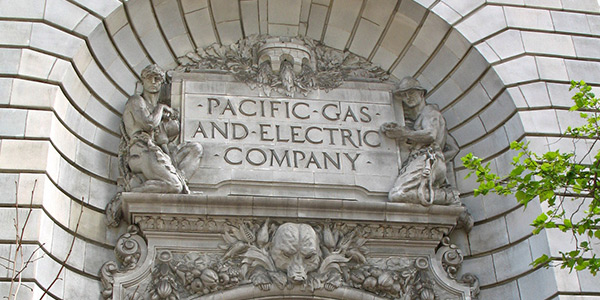By Michael Brooks
The judge overseeing PG&E Corp.’s Chapter 11 bankruptcy questioned the utility’s attorney last week over a proposed compensation package that includes about $11 million in performance-based bonuses for 12 executives.
At a hearing in San Francisco on Friday, Judge Dennis Montali, of the U.S. Bankruptcy Court for the Northern District of California, said he took issue with the language included in a PG&E court filing supporting its key employee incentive program (KEIP), filed with the U.S. Securities and Exchange Commission in late June.
The utility told the court its board of directors’ compensation committee had “determined that the KEIP was necessary to appropriately incentivize and align the KEIP participants’ goals and performance with those of the [company] and … to provide the KEIP participants with the opportunity to achieve a market rate of compensation, but only if the KEIP performance goals are achieved.”
Montali told PG&E attorney Stephen Karotkin that he had a problem with the phrase “appropriately incentivize,” recalling that the utility’s equipment was responsible for some of the worst wildfires in the history of the state.
“If they’re not incentivized enough, they ought to find another job, frankly,” the judge said.
Karotkin defended the bonuses, saying they would only be paid if the executives met certain targets. He assured the judge that they were dedicated to safety and regaining state residents’ trust.
Montali also said he found it “troublesome” that the utility paid its new CEO, former Tennessee Valley Authority CEO Bill Johnson, a $3 million signing bonus without disclosing it to the court. Although the company disclosed the payment in an SEC filing and it was reported on in the press, it was paid before the company filed the KEIP with the court, which appeared to perturb the judge.
After a long back-and-forth with an attorney from the U.S. Trustee Program, who ultimately said he did not find the payment improper, Montali decided against ordering Johnson to disgorge the payment, though he scolded PG&E for being “too clever by half.”
CPUC ‘Protocol’ Talks Fail
Friday’s hearing was set to discuss the results of negotiations between the California Public Utilities Commission and several ad hoc groups of bondholders, insurers and wildfire claimants that have asked Montali to terminate PG&E’s exclusivity period — the time it has to offer a reorganization plan without the judge having to weigh competing proposals. The other stakeholders want the court to consider their own bankruptcy plans.
PUC attorney Alan Kornberg last month persuaded Montali to give the commission, Gov. Gavin Newsom’s office and the groups time to work out a “protocol” — a process and timeline for the commission to consider all the competing plans and file one with the judge. Kornberg said the effort could expedite the process by eliminating the need for Montali to review several plans.
Under Assembly Bill 1054, passed last month, the PUC must approve a bankruptcy plan by June 30, 2020, for PG&E to be able to access a $21 billion fund to pay wildfire claims. (See California PUC Jumps into PG&E Bankruptcy Fray.)
But on Friday, Kornberg reported that talks had broken down, with the groups apparently insisting that PG&E play no role in selecting a restructuring plan. Montali directed Kornberg and the several attorneys representing the other parties to the discussions not to give him details of the talks so as not to prejudice himself before he rules on the groups’ motions to terminate exclusivity on Tuesday.
Kornberg did say that several parties had told him they were confident the legislature would extend the June 30 deadline. An attorney for Newsom’s office called banking on that “an unintelligent move.”
Montali asked Kornberg if the PUC could begin to work on its own approval process simultaneously with the court. Kornberg said the commission needed a court-approved plan to consider; otherwise, it could waste time and resources considering a plan that might not ultimately be approved.
Earnings
The hearing came after PG&E reported earlier that day that it had lost $2.55 billion ($4.83/share) in the second quarter. The company posted a loss of $983 million ($1.91/share) for the second quarter last year.
The loss included a $3.9 billion pre-tax charge for estimated third-party claims related to the 2017 Northern California wildfires and the 2018 Camp Fire. The company has lost about $2.4 billion this year; it posted a profit of $136 million ($0.25/share) for the first quarter.
Total revenue for the second quarter was down about 7%, from about $4.2 billion in 2018 to about $3.9 billion this year.
“Items impacting comparability for the quarter also include enhanced and accelerated electric asset inspection costs; clean-up and repair costs related to the 2018 Camp Fire; legal and other costs related to the 2017 Northern California wildfires and the 2018 Camp Fire; and financing, legal and other costs related to PG&E Corp.’s and Pacific Gas and Electric Co.’s reorganization cases under Chapter 11 of the U.S. Bankruptcy Code,” the company said in a statement.
“Our primary focus areas are to further reduce the risk of wildfires in the communities we serve, to improve our safety and operational performance across the board, and to move expeditiously through the Chapter 11 process, which includes paying wildfire victims fairly and as soon as possible,” Johnson said. “We recognize we are operating from a deficit when it comes to public trust, and to regain that trust, we must sustain excellent operational performance day after day, month after month, year after year.”




